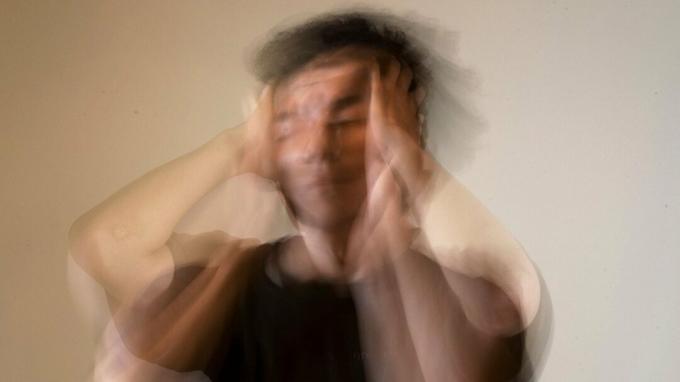Panic Attacks: what are they and how are they treated?
Panic happens when a person suffers an anxiety attack and is unable to identify the cause of the attack.. In this way, the person understands that those sensations he is experiencing could be a sign either that her life is at risk or that she is going crazy or even both.
The reality of anxiety
Normally among the most characteristic anxiety sensations that they usually report People who suffer from panic attacks include tachycardia, a feeling of suffocation, shortness of breath, a feeling of unreality, dry mouth, trembling and/or sweating, among others.. They can be many more and also very specific depending on the person and the details.
All of these responses are generated because the Sympathetic Nervous System (SNS) is triggered; a system that all human beings have and that belongs to the Autonomous Nervous System (ANS), that is, it triggers autonomously or automatically, and it is a primitive system that has allowed us to survive as a species throughout history (and prehistory, for that matter). supposed).
Let us imagine in your case that thousands of years ago a mammoth appeared with an offensive intention in the village of a tribe of primitive human beings. The moment any of these homos sees the tremendous and horned animal, their Sympathetic Autonomous Nervous System is triggered without further ado, thus preparing their body for fight or flight. That is to say, the heart rate accelerates, the pupils dilate and the eyes expand their field of vision, the muscles They maintain their tone, their digestion stops, the mouth runs out of saliva and their entire body is ready to fend, stay completely still so as not to be seen or run away. If this autonomous system failed, the primitive human being would not react with the diligence that the situation requires and would probably be eliminated in a few seconds by the mammoth.
Imagine today. And imagine that you are going to cross a green light and you see a car at 90 km/h coming straight to hit you. What is going to happen? Are you going to stay as if nothing happened? Are you going to ask your body to speed up to react? What is going to happen is that whatever you think, your Sympathetic Autonomous Nervous System at the spinal level is going to trigger and prepare you to react urgently; Your heart is going to go a mile an hour, your pupils dilate and your field of vision will expand, your muscles will They will have either to run away or to make you stay still and not continue crossing (which in this case is what same).
In simple words, the shock that enters your body allows you to react or paralyzes you as an alternative reaction.. And this is thanks to the Sympathetic Nervous System. The same thing happens that happened thousands of years ago when a mammoth appears unexpectedly in the tribe's village.

What then is Panic or Panic Disorder with or without agoraphobia?
When a person is calmly at home, at work or on the street and their Sympathetic ANS triggers without apparent cause. That is, without evidence of a differentiating element by which the person understands that the attack has occurred. Something like saying: without the mammoth being there.
It turns out that human beings are very complex and We can think about something that scares us without this something being physically in front of our eyes and this can trigger our Sympathetic Autonomous Nervous System just as if we saw it.. Of course in this case and making a small play on words for us this system would have little to like... Rather it would be an unfriendly system for us... We were calmly and suddenly bam! All anxiety is triggered... We feel attacked without an apparent attack.
Furthermore, it happens that we are actually aware of very little. It is estimated that we are aware of less than 95% of what we think, see and/or perceive. With which some non-conscious “mammoth-type” idea may have crossed our minds or we may have unconsciously perceived some contextual clue that for us makes us just like the mammoth in the example of populated. Our Sympathetic Nervous System has triggered on its own and without apparent cause and we also don't know how Why are we experiencing tachycardia, sweating, tremor, dry mouth, difficulty breathing? swallow.
In short, we have not identified the anxiety trigger because nothing has happened to apparently justifies it, we have not seen any car that was going to hit us and of course neither no mammoth. In fact, we were calmly at home or at work and our hearts were racing. So we get scared and think that we are probably seriously ill, and therefore it seems obvious that we are going to die or that we are going to have a heart attack because something seems to be wrong in our body and our heart. This is Panic.
We will refer to Panic with or without agoraphobia. If the person has stopped going out or is avoiding situations with more people in which they understand that they might not be helped. Example: bus, subway, shopping center, etc. The word Agora comes from Greek and means meeting, square or urban space conceived as a social, political or administrative center. Therefore, Panic with agoraphobia occurs when the person has stopped going to certain social areas for fear of not being helped if they suffered a panic attack. For example, he does not take the bus in case he has a panic attack because he thinks he could die while there without getting help.
Treatment
Panic is one of the most common Anxiety Disorders and its treatment is not particularly complicated as long as the person is willing to make the changes and face the situations and sensations. In short, as long as you trust the therapist in front of you.
From a cognitive-behavioral approach, in the first phase of treatment, the person was usually informed about what Panic is, as I have done in the first part of this article. Then, in successive sessions, this information is adapted to the particular situations in the life of the person. person and explains by doing a functional analysis what actions and situations are maintaining the problem.
However, from other third generation therapies such as Acceptance and Commitment Therapy (ACT), no theoretical explanations of this type are given. Nor is the person informed of the fact that Panic is a disorder as such. Well, truly mental disorders are nothing more than clinically useful entelechies. They have no real existence. From ACT, the treatment of the problem, in my experience, is equally or even faster, effective and lasting over time. José Luis López “Cheli”.



